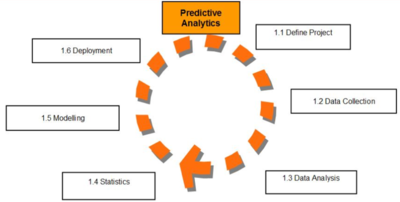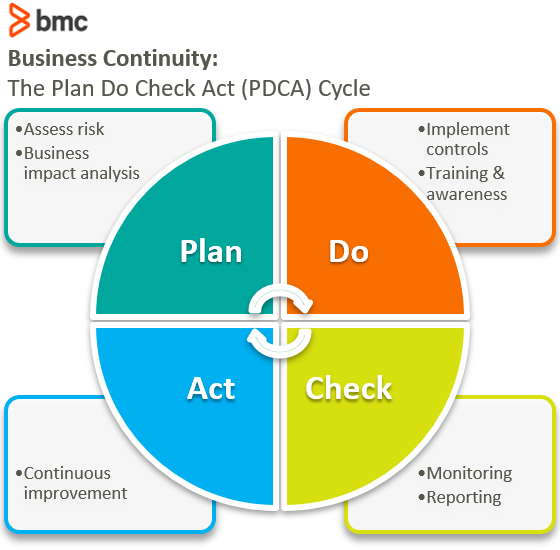Companies employ predictive analytics to find patterns in this data to identify risks and opportunities. Predictive analytics is a branch of advanced analytics that makes predictions about future outcomes using historical data combined with statistical modeling data mining techniques and machine learning.
With a collaborative set of past and current data businesses can generate precise.

Predictive analytics definition. Definition Predictive analytics is a broad term for using historical and current data to make projections about what might happen in the future. Before doing any analysis it is difficult to know what those factors are. Predictive Analytics Definition Predictive Analytics is a statistical method that utilizes algorithms and machine learning to identify trends in data and predict future behaviors.
Thanks to computational advancement it is already possible to analyze large volumes of data Big Data to find patterns and evaluate future possibilities from its history. Predictive analytics is a type of AI software when it is powered by a machine learning model but this has only become more common in recent years. Predictive analytics provides estimates about the likelihood of a future outcome.
Predictive analytics definition Predictive analytics is a branch of advanced analytics that makes predictions about future events behaviors and outcomes. Predictive analysis is an advanced analytical technique that uses data algorithms and machine learning to anticipate trends and make business projections. It uses statistical techniques including machine learning algorithms and sophisticated predictive modeling to analyze current and historical data and assess the likelihood that something will take place even if that something isnt on a.
In the case of Netflix all we had were mere conjectures. Predictive analytics uses many techniques from data mining statistics modeling machine learning and artificial intelligence to analyze current data to make predictions about future. The goal of Predictive Analytics is being deployed by the mathematical and computational methods for predicting the outcome of an event or process.
Prior to this the term predictive analytics referred to the use of multiple distinct business intelligence techniques to determine the. Predictive analytics is a type of data science that uses historical information and analysis tactics such as statistic modeling and machine learning to predict future trends. In business it can be used to model various scenarios for how customers react to new product offerings or promotions and how the supply chain might be affected by extreme weather patterns or demand spikes.
Predictive analytics is the technique that enables you to find and uncover the factors that indicate the event illustrated in each case above is about to occur. Predictive analytics is the use of statistics and modeling techniques to determine future performance. Predictive analytics refers to the analysis of big data to make predictions and determine the likelihood of future outcomes trends or events.
Predictive analytics has its roots in the ability to predict what might happen. The goal is to go beyond knowing what has happened to providing a best assessment of what will happen in the future. The enhancement of predictive web analytics calculates statistical probabilities of future events online.
Predictive analytics provides companies with actionable insights based on data. Predictive analytics is the use of data statistical algorithms and machine learning techniques to identify the likelihood of future outcomes based on historical data. These analytics are about understanding the future.
Predictive analytics is an area of statistics that deals with extracting information from data and using it to predict trends and behavior patterns. It is used as a decision-making tool in a variety of industries and disciplines such as. What is Predictive Analytics.
Making predictions about whats next about the future is hard-wired into the human brain. Predictive analytics definition The unprecedented amount of data generated by Internet-enabled devices and machines has given rise to predictive analytics the practice of building analytical models that interpret this data in order to predict the likely outcome of future scenarios. The process of the predictive modeling is based on the forecast of a certain future state that is based on the changes that happen to.
With increasing pressure to show a return on investment ROI for implementing learning analytics it is no longer enough for a business to simply show how learners performed or how they interacted with. What is predictive analytics. Predictive analytics is the branch of the advanced analytics which is used to make predictions about unknown future events.
Predictive analysis more commonly known as predictive analytics is a type of data analysis which focuses on making predictions about the future based on data.
 What Is Predictive Analytics Predictive Analytics Definition Pyramid Analytics
What Is Predictive Analytics Predictive Analytics Definition Pyramid Analytics
 What Is Predictive Analytics Definition And Faqs Omnisci
What Is Predictive Analytics Definition And Faqs Omnisci
 Predictive Analytics What It Is And Why It Matters Sas
Predictive Analytics What It Is And Why It Matters Sas
 4 Types Of Data Analytics To Improve Decision Making
4 Types Of Data Analytics To Improve Decision Making
 What Is Predictive Analytics Definition From Whatis Com
What Is Predictive Analytics Definition From Whatis Com
 Data Analytics Vs Predictive Analytics Find Out 6 Awesome Differences
Data Analytics Vs Predictive Analytics Find Out 6 Awesome Differences
 Predictive Analytics Data Analysis Predictive Model
Predictive Analytics Data Analysis Predictive Model
 What Is Predictive Analytics Predictive Analytics Definition Pyramid Analytics
What Is Predictive Analytics Predictive Analytics Definition Pyramid Analytics
 Levels Of Data Analytics Ithappens Nu
Levels Of Data Analytics Ithappens Nu
 The 4 Types Of Data Analytics Kdnuggets
The 4 Types Of Data Analytics Kdnuggets
 What Is Predictive Analytics What Does Predictive Analysis Mean Predictive Analysis Meaning Youtube
What Is Predictive Analytics What Does Predictive Analysis Mean Predictive Analysis Meaning Youtube
 What Is Predictive Analytics 3 Real World Examples Of Predictive Analytics In Business Intelligence
What Is Predictive Analytics 3 Real World Examples Of Predictive Analytics In Business Intelligence
 What Is Predictive Analytics Predictive Analytics Definition Pyramid Analytics
What Is Predictive Analytics Predictive Analytics Definition Pyramid Analytics



No comments:
Post a Comment
Note: Only a member of this blog may post a comment.